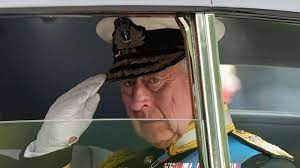
After the long wait of 70 years, King Charles III, with all of Britain’s pomp and pageantry, inherited the crown from his mother, Queen Elizabeth II. But to put it plainly, and not having to sound crude, it takes a tad of grit to be this cold and brazen!
Britain is in a dangling situation; it not only has its economy in the doldrums, but what’s worse is that it has an irresponsible leader flippant enough to splurge the national affluence for vanity in times of crisis. At a time when economically ravaged Britain is struggling to make ends meet, it is incomprehensible to burden British taxpayers with the ceremony’s exorbitant expenditure.
The double-digit inflation, unbearable living costs, record joblessness, 35% year-on-year rise in food prices, long-denied pay raises for doctors, nurses, transport workers, and many others, and disproportionate pay raises to inflation rates have irked notable young people to question how much of the lavish lifestyle of the royal family the public should be subsidizing. In a recent poll in Britain by market research firm YouGov and the British news program Panorama, 58% of respondents believed that the monarchy should be abolished. And only 36% of respondents thought Charles was in touch with the lives of everyday Britons.
Alas! But far from any legally binding procedure, Buckingham Palace has to shell out millions of dollars of taxpayers’ money for the coronation ceremony to sell the royal brand. The glitzy coronation, estimated to have a cost ranging from $63 million to $125 million by the Operation Golden Orb committee, has gathered the dissonance of everyday Britons. Read the room, King Charles. The colourful vanity parade of King Charles showcased billions of dollars’ worth of jewels, golden carriages, crowns, scepters, and swords from the family’s vaults. It is unequivocal that most of the jewels and regalia can trace their roots back to India and other British colonies, including the Kohinoor, the Great Star of Africa, the Cullinan II, and many other jewels. Amid the death of Queen Elizabeth II and now the coronation of King Charles, there have been growing calls from across the former British colonies for the repatriation of their historic possessions, though it is very unlikely.
Enough distaste has been expressed about the extravagant coronation of King Charles III, and rightly so, but more than the surfeit of scrutiny over the lavish event or the fresh questions over the relevance of a monarchy, the royal relic is yet to face the music. The peacocking of the royal relics has, once again, raised the age-old question: are these priceless jewellery and regalia for the British to use? India has had a very jaded affair with the British Empire. With less to contradict, Britain’s rise for two hundred years rests upon its depredations in India. From a surplus share of 23% in the world’s economy to a minute 4%, having one-sixth of soldiers fighting the war as Indians, to the creation of racial, ethnic, and religious tensions, India has seen it all. Centuries of bloodshed and betrayals are the pillars that financed the British throne, and the inherited crown, of course, has a history of their cruel colonial past, the lands they looted, the blood of the relatives, slaves, and colonial subjects they executed, and the slavery they perfected.
Furthermore, the archaic monarchy has a long and perplexing history of being an inherently anti-feminist and oppressive institution. The arcane and outdated traditions have continued the oppression of women for years in the royal family. British people still disapprove of the royal family for treating Princess Diana, who is without a doubt the family’s undeniable star, badly. To her credit, the princess used her popularity to raise awareness for concerning causes such as leprosy, domestic violence, landmines in Angola, and mental health. Her popularity, however, was not without its challenges. Diana’s pragmatic approach to fellow citizens severely violated the fundamentally traditional idea of the royal family and was considered a dereliction of her duties by the institution. Talking about her bulimia, Diana said that it was a sign of “crying out for help”, instead of how the royal family dismissed it as her being “unstable”.
Moreover, the overtly patriarchal system of male-preference primogeniture was not abolished until 2013. Among several other sexist protocols, one strictly forbids the royals from making a public appearance during pregnancy and talking about it. Later, the coverage of Prince Harry’s relationship with Meghan Markle was subjected to racial paranoia and xenophobia. Blame the media as much as you like, but the historically interwoven idea of “Britishness” is the wind beneath its sails. In a shocking revelation, Markle disclosed that she had felt suicidal but was prohibited from seeking help by a senior British official as it “wouldn’t be good for the institution”. May be that is why after Adele and Ed Sheeren, artistes like Elton John, Harry Styles, Spice Girls, etc have turned down the offer to perform at the coronation ceremony of King Charles III.
From where I see, I see a senile, racist and doddering monarch with a hangover of its colonial supremacist past commanding a Chistian state that flaunts on its liberal and secular credentials, all the while pontificating the East on morals. This plain sense of hubris must be shred off to the least.

The writer is a Gujarat-based social activist and founder of Ek Soch NGO.